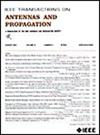Commonly Differentially Hybrid-Fed Method for Isolation Enhancement in Two-Port Co-Polarized Co-Radiator Applications
IF 4.6
1区 计算机科学
Q1 ENGINEERING, ELECTRICAL & ELECTRONIC
引用次数: 0
Abstract
This study introduces a decoupling method for isolation enhancement in two-port co-polarized co-radiator applications, called the commonly differentially hybrid-fed (CDHF) decoupling method. Unlike conventional feed architectures, the proposed feed architecture allocates two ports to feed the antenna with a power divider and an anti-phase power divider. Theoretical analysis indicates that this feed architecture offers particularly high isolation. Generally, for two-port antennas (with one port supporting Wi-Fi 6 applications and another supporting Wi-Fi 6E applications), suppressing mutual coupling effects using traditional filters is challenging owing to the extremely narrow guard band of 0.09 GHz. The CDHF decoupling method offers a filter-free solution to this problem. To validate its effectiveness, a two-por co-polarized co-radiator patch antenna using this method is designed, fabricated, and tested. Results reveal that the two ports of the antenna, respectively, cover the Wi-Fi 6 U-NII-3 (5.725–05.835 GHz) and Wi-Fi 6E U-NII-5 bands (5.925–6.425 GHz). Furthermore, the antenna achieves an isolation exceeding 35 dB across the 5.5–6.5-GHz frequency range. Moreover, the antenna exhibits both conical and broadside radiation patterns, making it suitable for indoor scenarios requiring radiation pattern diversity, such as offices and supermarkets.在双端口同极化共辐射器应用中增强隔离度的共用差分混合馈电法
本研究介绍了一种在双端口同极化共辐射器应用中增强隔离度的去耦方法,称为普通差分混合馈电(CDHF)去耦方法。与传统的馈电架构不同,所提出的馈电架构分配了两个端口,通过功率分配器和反相功率分配器向天线馈电。理论分析表明,这种馈电架构的隔离度特别高。一般来说,对于双端口天线(一个端口支持 Wi-Fi 6 应用,另一个端口支持 Wi-Fi 6E 应用),由于 0.09 GHz 的守备频带极窄,使用传统滤波器抑制相互耦合效应具有挑战性。CDHF 去耦方法为这一问题提供了一种无需滤波器的解决方案。为了验证这种方法的有效性,我们设计、制造并测试了采用这种方法的双端口同极化共辐射器贴片天线。结果显示,天线的两个端口分别覆盖了 Wi-Fi 6 U-NII-3 频段(5.725-05.835 GHz)和 Wi-Fi 6E U-NII-5 频段(5.925-6.425 GHz)。此外,该天线在 5.5-6.5 GHz 频率范围内的隔离度超过 35 dB。此外,该天线还具有锥形和宽边两种辐射模式,适用于办公室和超市等需要辐射模式多样性的室内场景。
本文章由计算机程序翻译,如有差异,请以英文原文为准。
求助全文
约1分钟内获得全文
求助全文
来源期刊
CiteScore
10.40
自引率
28.10%
发文量
968
审稿时长
4.7 months
期刊介绍:
IEEE Transactions on Antennas and Propagation includes theoretical and experimental advances in antennas, including design and development, and in the propagation of electromagnetic waves, including scattering, diffraction, and interaction with continuous media; and applications pertaining to antennas and propagation, such as remote sensing, applied optics, and millimeter and submillimeter wave techniques

 求助内容:
求助内容: 应助结果提醒方式:
应助结果提醒方式:


